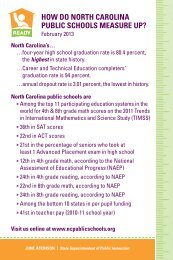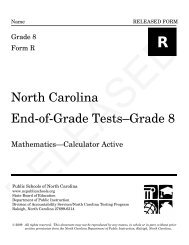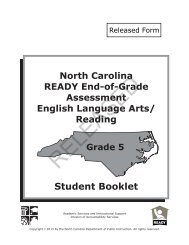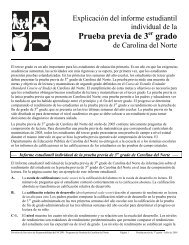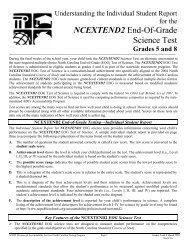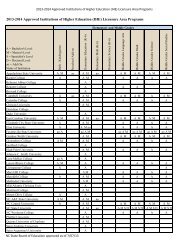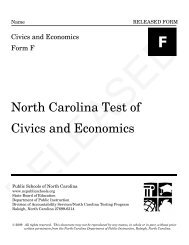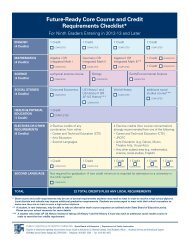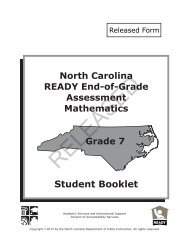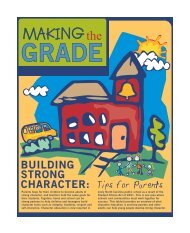North Carolina Writing Assessments: Grades 4 and 7
North Carolina Writing Assessments: Grades 4 and 7
North Carolina Writing Assessments: Grades 4 and 7
Create successful ePaper yourself
Turn your PDF publications into a flip-book with our unique Google optimized e-Paper software.
This publication <strong>and</strong> the information contained within must<br />
not be used for personal or financial gain. <strong>North</strong> <strong>Carolina</strong><br />
LEA school officials <strong>and</strong> teachers, parents, <strong>and</strong> students<br />
may download <strong>and</strong> duplicate this publication for<br />
instructional <strong>and</strong> educational purposes only. Others may<br />
not duplicate or quote from this publication without prior<br />
written permission from the NCDPI Division of<br />
Accountability Services/Testing Section.
Public Schools of <strong>North</strong> <strong>Carolina</strong><br />
Assessment Brief<br />
State Board of Education • Phillip J. Kirk, Jr., Chairman • <strong>North</strong> <strong>Carolina</strong> Department of Public Instruction • Michael E. Ward, Superintendent<br />
Fall 1999<br />
Vol. 6, No. 6<br />
<strong>North</strong> <strong>Carolina</strong> <strong>Writing</strong> <strong>Assessments</strong>:<br />
<strong>Grades</strong> 4 <strong>and</strong> 7<br />
This publication is an update to the Winter 1999 Assessment<br />
Brief “<strong>North</strong> <strong>Carolina</strong> <strong>Writing</strong> <strong>Assessments</strong>: <strong>Grades</strong> 4, 7,<br />
<strong>and</strong> 10 (Vol. 5, No.1). It is also available at<br />
www.dpi.state.nc.us/accountability/testing (Testing Section<br />
Website). Information regarding the <strong>North</strong> <strong>Carolina</strong> Endof-Course<br />
Test of English II will be located in a separate<br />
Assessment Brief.<br />
Background <strong>and</strong> Introduction<br />
The <strong>North</strong> <strong>Carolina</strong> General Assembly in 1977 enacted<br />
legislation directing the <strong>North</strong> <strong>Carolina</strong> State Board of Education<br />
(NCSBE) to evaluate annually the educational progress of<br />
<strong>North</strong> <strong>Carolina</strong> students in the first, second, third, sixth, <strong>and</strong><br />
ninth grades. “A Plan for the Measurement of <strong>Writing</strong> in <strong>North</strong><br />
<strong>Carolina</strong>” was presented to <strong>and</strong> approved by the NCSBE in<br />
November, 1982. As described in that plan, a field test of sixth<br />
<strong>and</strong> ninth graders was conducted in the spring of 1983, <strong>and</strong><br />
formal administrations in both grades occurred in January, 1984.<br />
In 1985-86, the writing assessment at grade 9 was reassigned<br />
to grade 8. The program was exp<strong>and</strong>ed in 1992-93 to include<br />
writing at grade 4. Currently, students are administered the<br />
<strong>North</strong> <strong>Carolina</strong> <strong>Writing</strong> Assessment at grades 4 <strong>and</strong> 7.<br />
<strong>Writing</strong> assessments were added initially to the <strong>North</strong> <strong>Carolina</strong><br />
Testing Program in 1983-84 to place a greater statewide<br />
emphasis on writing. The revised <strong>North</strong> <strong>Carolina</strong> St<strong>and</strong>ard<br />
Course of Study (SCS) emphasizes writing as a basic skill<br />
that can be improved with appropriate instructional emphasis.<br />
The measurement of writing ensures that ample time <strong>and</strong><br />
resources are allotted for its development in the classroom.<br />
Student performance in writing is measured statewide at grades<br />
4 <strong>and</strong> 7. Students in grade 4 are asked to write a narrative<br />
composition (personal or imaginative), <strong>and</strong> students in grade 7<br />
are asked to write either an expository (clarification or pointof-view)<br />
or descriptive composition.<br />
Procedures for Test Administration<br />
On the day of the test administration, the teacher removes<br />
individual copies of a writing prompt from a sealed envelope.<br />
Testing Section<br />
At each grade the writing prompt provides instructions that set<br />
forth the task. Each student has fifty minutes to write an ondem<strong>and</strong><br />
composition in response to the prompt. Additional<br />
time may be allotted to students with special needs.<br />
Students in grade 4 must write a short story from something<br />
they have experienced, read, or imagined. Students in grade 7<br />
are required to write a composition to explain/clarify a situation/<br />
position, defend a position, or describe a place or object.<br />
Reporting Test Results<br />
Each year students’ scored compositions <strong>and</strong> a scoring guide<br />
are returned to all fourth <strong>and</strong> seventh-grade teachers several<br />
weeks after scoring. Teachers are encouraged to use the<br />
scoring guides <strong>and</strong> the scoring criteria to interpret scores for<br />
students <strong>and</strong> parents.<br />
Summary scores are also returned to all schools <strong>and</strong> school<br />
systems. Summary scores for the LEAs are included in a<br />
state-generated report.<br />
Scoring the Compositions<br />
Two independent readers, who have received extensive training<br />
in the scoring process, score each student’s composition. At<br />
each grade, the composition is assigned either a 1, 2, 3, 4, or<br />
Non-Scorable (NS). For essays where the two scores are<br />
discrepant by a single score point, a mid-point score is assigned<br />
to the student’s composition. For example, a student may<br />
receive a score of 2.5.<br />
The assigned score reflects each student’s performance with<br />
respect to four main criteria: (1) main idea, (2) supporting<br />
details, (3) organization, <strong>and</strong> (4) coherence. This “focusedholistic<br />
score” defines the student’s comm<strong>and</strong> of the mode of<br />
writing being assessed.<br />
A second, independent score represents a measure of the<br />
student’s ability to use st<strong>and</strong>ard English conventions which<br />
include complete sentences, appropriate word forms, st<strong>and</strong>ard<br />
mechanics (i.e., punctuation, capitalization), <strong>and</strong> correct spelling.<br />
This score is reported as a “+” or “-”. The “+” paper exhibits<br />
NCDPI/ Division of Accountability Services
an acceptable level of proficiency in sentence formation,<br />
usage, mechanics, <strong>and</strong> spelling; the “-” paper does not exhibit<br />
an acceptable level of proficiency. Since two readers score<br />
each essay for use of language conventions, each essay<br />
receives a score of “++,” “+-,” or “--.”<br />
Each year that the same mode of writing is assessed (i.e.,<br />
narrative, descriptive, or expository), the scoring criteria <strong>and</strong><br />
score point scale used are identical. The scoring guide,<br />
however, is developed containing student papers that<br />
demonstrate st<strong>and</strong>ards that correspond to each prompt.<br />
The focused-holistic score scale for each mode of writing<br />
assessed at grades 4 <strong>and</strong> 7 follows.<br />
Grade 4 Narrative Composition<br />
Score Point 4. The response exhibits a strong comm<strong>and</strong> of<br />
narrative writing. The response is focused <strong>and</strong> has an<br />
effective sequencing of events <strong>and</strong> a clear progression of<br />
ideas. The writer provides specific, relevant details to support<br />
ideas. The composition is unified <strong>and</strong> well elaborated. The<br />
writer’s organization provides a clear strategy or controlled<br />
plan; the composition progresses logically <strong>and</strong> has a sense of<br />
overall completeness.<br />
Score Point 3. The response exhibits a reasonable comm<strong>and</strong><br />
of narrative writing. The response is focused <strong>and</strong> establishes<br />
progression of ideas <strong>and</strong> events although minor lapses in focus<br />
<strong>and</strong> progression may be present. The composition contains<br />
elaboration <strong>and</strong> support in the form of specific details. The<br />
composition may have minor weaknesses in coherence. The<br />
writer’s organization provides a reasonable sense of logical<br />
progression <strong>and</strong> overall completeness.<br />
Score Point 2. The response exhibits a weak comm<strong>and</strong> of<br />
narrative writing. The response exhibits some progression of<br />
ideas <strong>and</strong> events <strong>and</strong> provides some elaboration <strong>and</strong> support.<br />
The elaboration is relevant but may be flawed. The<br />
composition may not be evenly elaborated, having a list-like<br />
quality with concrete supporting details. The composition may<br />
have little connection between a controlling idea <strong>and</strong> supporting<br />
details relevant to development.<br />
Score Point 1. The response exhibits a lack of comm<strong>and</strong> of<br />
narrative writing. There is evidence that the writer has read<br />
the prompt <strong>and</strong> attempted to respond to it. The writer may<br />
attempt to support ideas, but there may be no sense of strategy<br />
or control, or the writer may exhibit skeletal control but the<br />
response is too sparse to be scored higher than a “1.” The<br />
response may not sustain focus on the topic, may lack clarity,<br />
<strong>and</strong>/or may have an inappropriate strategy.<br />
Non-Scorable (NS). Non-scorable compositions are entirely<br />
illegible or otherwise unscorable: blank responses, responses<br />
written in a foreign language, restatements of the prompt,<br />
<strong>and</strong> responses that are off topic or incoherent.<br />
Testing Section<br />
Grade 7 Descriptive Composition<br />
Score Point 4. The response exhibits a strong comm<strong>and</strong> of<br />
descriptive writing. The writer consistently focuses on the<br />
subject matter <strong>and</strong> provides sufficient, specific, relevant<br />
descriptors <strong>and</strong> details as a means of elaboration. The writer’s<br />
organization provides a strategy or controlled plan with a sense<br />
of logical progression <strong>and</strong> overall completeness. The<br />
composition is coherent.<br />
Score Point 3. The response exhibits a reasonable comm<strong>and</strong><br />
of descriptive writing. The writer focuses on the subject matter<br />
<strong>and</strong> provides sufficient descriptors <strong>and</strong> details as a means of<br />
elaboration. The writer’s organization provides a strategy or<br />
plan with a reasonable sense of logical progression. The<br />
response is generally coherent <strong>and</strong> complete overall, although<br />
minor weaknesses may be present.<br />
Score Point 2. The response exhibits a weak comm<strong>and</strong> of<br />
descriptive writing. The writer focuses on the subject matter,<br />
although the writer may drift from focus. Some of these<br />
responses contain many bare details while others have a few<br />
details, some of which are elaborated. These responses may<br />
be poorly organized <strong>and</strong> may not establish a logical progression,<br />
although some sense of strategy exists.<br />
Score Point 1. The response exhibits a lack of comm<strong>and</strong> of<br />
descriptive writing. There is evidence that the writer has<br />
seen <strong>and</strong> attempted to respond to the prompt. However, the<br />
response may not sustain focus on the topic. The writer may<br />
attempt to describe, but there may be no sense of strategy or<br />
control. Many responses exhibit skeletal control but the<br />
description may be irrelevant or too sparse to be scored higher<br />
than a “1.”<br />
Non-Scorable (NS). Non-scorable compositions are entirely<br />
illegible or otherwise unscorable: blank responses, responses<br />
written in a foreign language, restatements of the prompt,<br />
<strong>and</strong> responses that are off topic or incoherent.<br />
Grade 7 Expository Composition<br />
Score Point 4. The response exhibits a strong comm<strong>and</strong> of<br />
expository writing. The writer focuses on the subject matter<br />
<strong>and</strong> provides specific relevant reasons <strong>and</strong> details to support<br />
reasons as a means of elaboration. The writer’s organization<br />
provides a strategy or controlled plan with a clear sense of<br />
logical progression <strong>and</strong> overall completeness. The composition<br />
is coherent.<br />
Score Point 3. The response exhibits a reasonable comm<strong>and</strong><br />
of expository writing. The writer focuses on the subject matter<br />
<strong>and</strong> given reasons to support the main idea. Some responses<br />
contain a few well-elaborated reasons or more reasons with<br />
less elaboration. The writer’s organization provides a<br />
reasonable sense of logical progression. The response is<br />
generally coherent <strong>and</strong> complete overall, although minor<br />
weaknesses may be present.<br />
NCDPI/ Division of Accountability Services
Score Point 2. The response exhibits a weak comm<strong>and</strong> of<br />
expository writing. The writer focuses on the subject matter<br />
<strong>and</strong> gives at least one or two reasons or else a list of reasons<br />
with little or no elaboration. These responses may be poorly<br />
organized <strong>and</strong> may not establish a logical progression, but some<br />
sense of strategy exists. Some responses introduce reasons<br />
<strong>and</strong> ideas which are not explained or related to the subject<br />
matter, causing the reader to have to make inferences.<br />
Score Point 1. The response exhibits a lack of comm<strong>and</strong> of<br />
expository writing. There is evidence that the writer has seen<br />
<strong>and</strong> attempted to respond to the prompt. However, the response<br />
may not sustain focus on the topic. The writer may attempt to<br />
support ideas, but there may be no sense of strategy or control.<br />
Many responses exhibit skeletal control but may be too sparse<br />
to be scored higher than a “1.”<br />
Non-Scorable (NS). Non-scorable compositions are entirely<br />
illegible or otherwise unscorable: blank responses, responses<br />
written in a foreign language, restatements of the prompt, <strong>and</strong><br />
responses that are off topic or incoherent.<br />
Achievement Levels<br />
Achievement levels, or performance st<strong>and</strong>ards, are available<br />
for interpreting student performance on the writing assessments.<br />
Achievement levels as a st<strong>and</strong>ard give common meaning<br />
throughout the state as to what is expected at various levels of<br />
competence in writing. These categories are used to better<br />
describe the scores on the tests. It is imperative to remember<br />
that the achievement levels for the writing assessment at grades<br />
4 <strong>and</strong> 7 are based on student performance for one on-dem<strong>and</strong><br />
writing task. There are four achievement levels. Level I<br />
includes Non-Scorables.<br />
Achievement Level Score Point Ranges<br />
Level IV 3.5-4.0<br />
Level III 2.5-3.0<br />
Level II 1.5-2.0<br />
Level I 0.0-1.0<br />
<strong>Writing</strong> St<strong>and</strong>ard<br />
The Accountability st<strong>and</strong>ard established for the writing<br />
assessment at grades 4 <strong>and</strong> 7 is Achievement Level III or above.<br />
This st<strong>and</strong>ard is reported as the Accountability indicator. The<br />
st<strong>and</strong>ard for the writing assessment at grades 4 <strong>and</strong> 7 is<br />
demonstrated by a score point of 2.5 or above on a four-point<br />
scale. By achieving a score at or above the st<strong>and</strong>ard, the<br />
student has demonstrated a reasonable comm<strong>and</strong> of the<br />
particular mode of writing assessed.<br />
Released <strong>Writing</strong> Assessment Prompts<br />
The following list contains the writing assessment prompts at<br />
grades 4 <strong>and</strong> 7 that have been released in previous years.<br />
Grade 4<br />
· Think about a special day that you have had. Tell about<br />
what happened that was special.<br />
· You have met many children at school or in your<br />
neighborhood with whom you have enjoyed spending time.<br />
Choose one <strong>and</strong> tell a story about a time you enjoyed with a<br />
friend.<br />
· One day your teacher enters your classroom, places a large<br />
bag on the desk, <strong>and</strong> leaves the room. Suddenly, the bag<br />
begins to move. Write a story about what happens.<br />
· One day you are walking home from school. You see a<br />
large, dirty glass bottle lying next to the road. You pick up<br />
the bottle <strong>and</strong> remove the top. Something surprising<br />
happens. Write a story about what happens.<br />
· Name a time that you were very surprised. Write a story<br />
about what happened that surprised you.<br />
· One morning you wake up <strong>and</strong> discover that you are only<br />
six inches tall. Write a story about what happens next.<br />
· Think about a time when something happened that made<br />
you very happy. Write a story about what happened that<br />
made you very happy.<br />
Grade 7<br />
· There are four seasons — fall, winter, spring, <strong>and</strong> summer.<br />
Choose your favorite season <strong>and</strong> explain why it is your<br />
favorite.<br />
· Think about an outdoor scene, such as a mountain, a beach,<br />
a waterfall, a park, that you consider interesting. Describe<br />
this sight so that your reader will be able to picture it.<br />
· Think about one place where people get together in large<br />
numbers. It could be a fairground, a school gymnasium or<br />
sports field, a theater, or any other place you may choose.<br />
Describe the place so that your reader will be able to picture<br />
it.<br />
· Take a position on whether violent shows should be shown<br />
on television. State your position <strong>and</strong> explain why you think<br />
violent shows should or should not be shown on television.<br />
· Take a position on whether your school should place more<br />
emphasis on sports. State your position <strong>and</strong> explain why<br />
you think your school should or should not place more<br />
emphasis on sports.<br />
Testing Section<br />
NCDPI/ Division of Accountability Services
· Think about a place where people go to have fun. It<br />
can be outdoors, a store, a relative’s, or any place where<br />
people go. Describe the place so that someone reading<br />
your paper could picture it.<br />
· Think about the kind of weather you like best. Name the<br />
kind of weather <strong>and</strong> explain why you like this kind of<br />
weather best.<br />
· Think about your favorite day of the week. Name your<br />
favorite day of the week <strong>and</strong> explain why it is your favorite.<br />
Strategies for Improving on Dem<strong>and</strong> <strong>Writing</strong><br />
· Ensure that students underst<strong>and</strong> the characteristics of<br />
the four modes of writing: narrative, descriptive,<br />
expository (clarification <strong>and</strong> point-of-view), <strong>and</strong><br />
argumentative (persuasive).<br />
· Have students use the writing process throughout the<br />
year to improve writing skills, but make them aware that<br />
the writing test is an on-dem<strong>and</strong> writing task. Therefore,<br />
help make them aware of the differences by assigning<br />
on-dem<strong>and</strong> writing tasks periodically.<br />
· Help students underst<strong>and</strong> the four composing<br />
characteristics.<br />
· Use sample papers to help students underst<strong>and</strong> the score<br />
scale used to score their essay.<br />
· Let students score each other’s essays <strong>and</strong> have them<br />
justify their scores by using the criteria <strong>and</strong> rubric.<br />
· Analyze prompts with students so they will read<br />
instructions closely <strong>and</strong> underst<strong>and</strong> expectations. Also,<br />
help them focus on the key word(s) in the prompt (e.g.,<br />
“tell a story,” “describe,” “explain,” “convince”) so that<br />
they will be able to classify by mode from the key words.<br />
Check to see if they can write prompts for a particular<br />
mode <strong>and</strong> explain what would be expected of them when<br />
responding to their prompts.<br />
· Encourage students to refer frequently to the prompt while<br />
they write to be sure they maintain focus on the main<br />
idea.<br />
· Help students analyze supporting details by instructing<br />
them to ensure supporting details are clearly linked to the<br />
main idea.<br />
· Be certain that any examples used add additional depth<br />
or underst<strong>and</strong>ing <strong>and</strong> do not just repeat the main idea.<br />
· Question whether adjectives used link back to the main<br />
idea or provide another level of underst<strong>and</strong>ing the prompt.<br />
· Underst<strong>and</strong> that a powerful verb is often more effective<br />
than a long string of adverbs.<br />
Testing Section<br />
· Use specific concrete modifiers (e.g., a “two-story house”<br />
rather than a “big house”).<br />
· Instruct students to be selective by encouraging them to<br />
determine which points are important <strong>and</strong> then to elaborate<br />
those points. Avoid giving students a specific number of<br />
points to include since an adequate number varies by topic.<br />
Also, emphasize that they should not lose the overall main<br />
idea (e.g., “Describe a kitchen.” The student may describe<br />
a stove, a refrigerator <strong>and</strong> a sink, but fail to describe how<br />
the entire kitchen looks.)<br />
· Avoid giving students a definite number of characteristics to<br />
produce (e.g., five paragraphs, ten adjectives, four reasons),<br />
since the number will vary by their choice of topics <strong>and</strong> the<br />
mode of writing.<br />
· Remember that requiring a definite number of characteristic<br />
leads to formula writing. Formula writing may occasionally<br />
help the weak writer to develop organization but may limit<br />
the able writer, who may allow organization to become the<br />
main focus <strong>and</strong> fail to provide sufficient supporting relevant<br />
details.<br />
· Underst<strong>and</strong> that sensory descriptors can enhance a student’s<br />
writing but that students generally have difficulty using the<br />
senses as an organizational strategy, which may weaken<br />
their overall focus. (Sensory description is often a forced<br />
organizational strategy because, depending on the student’s<br />
choice, certain senses may not be applicable <strong>and</strong> the student<br />
must deal in generalities, thereby providing vague supporting<br />
details.)<br />
· Read descriptive essays aloud to see if students can draw a<br />
mental picture. Read examples for different score points so<br />
they can see the importance of locators, size, <strong>and</strong> specific<br />
details.<br />
· Explain that students writing narrative essays should be able<br />
to construct a time line sequencing the events.<br />
· Emphasize that in persuasive <strong>and</strong> point-of-view writing<br />
students must give sound reasons with supporting details<br />
that show progression <strong>and</strong> that cause <strong>and</strong> effect writing is<br />
an effective method of elaboration. Students should not<br />
allow the cause <strong>and</strong> effect technique to overrule the content,<br />
since elaboration must be present.<br />
· Inform students that the writing assessment is one measure<br />
on one day of their school year scored by purely objective<br />
readers who use the criteria <strong>and</strong> score scale in the scoring<br />
guide.<br />
· Teach students that responses recorded on added horizontal<br />
lines, on unlined areas, as double-stacked sentences (i.e.,<br />
two sentences recorded on top of each other on one printed<br />
line), or on extra sheets of paper will not be scored. Students<br />
will be given credit only for sentences recorded on the<br />
horizontal lines printed in the test document.<br />
NCDPI/ Division of Accountability Services



